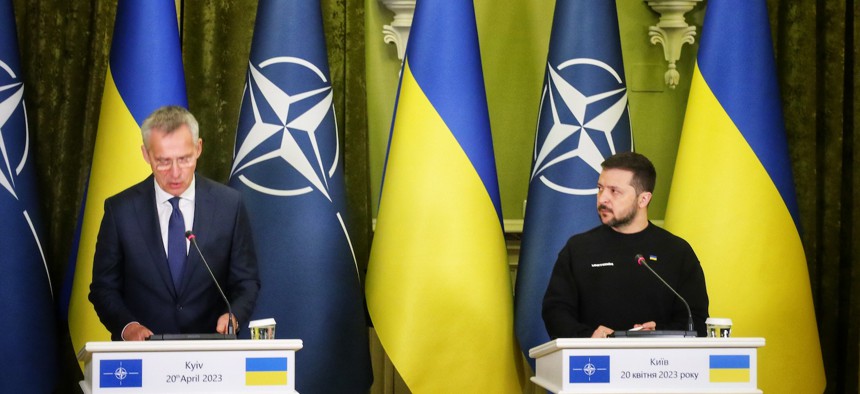
Secretary General of NATO Jens Stoltenberg (L) and President Volodymyr Zelenskyi (R) during a meeting on April 20, 2023 in Kyiv, Ukraine. Andriy Zhyhaylo / Obozrevatel / Global Images Ukraine via Getty Images
We Argued About Admitting Ukraine to NATO in 2008. Now We Agree on It.
The authors—longtime senior U.S. and German national-security figures—describe how they concluded that alliance membership is a necessary step.
We were at opposing ends at the NATO summit in Bucharest in 2008 when we disagreed on whether Ukraine was ready for membership. As a result, Ukraine was not offered a so-called Membership Action Plan. After 2008, and until President Putin’s 2014 attack on Ukraine, NATO never reverted to seriously discussing the vaguely expressed perspective at Bucharest that Ukraine would one day become a NATO member. The upcoming NATO summit at Vilnius is the right moment to make this perspective concrete. We agree now that NATO should establish a path that will help bring Ukraine closer to membership and pave the way for Ukraine to join NATO once Russia’s war against Ukraine has been successfully repelled.
Prior to Russia’s invasion of Ukraine in 2014, we had some sympathy for the idea that Ukraine could be a bridge between Russia and the West—with economic relations with both the EU and Russia’s Eurasian Union, and a military posture that threatened no one, along the line of the former Finnish model. Russia’s invasion of Ukraine in 2014 destroyed that idea, especially for Ukrainians. With its aggression, Russia brought about the very things that it later saw as compromising its security interests. It put NATO enlargement back on the agenda. And only then did NATO infrastructure start to move closer to Russia as a means of deterrence against further Russian military adventurism in Europe.
The last hope for Ukraine to become a bridge between East and West was reflected in the Minsk agreements but implementation foundered over Russian recalcitrance. It is wrong to claim that both sides were equally responsible for not implementing Minsk. It was Moscow that didn’t adhere to the ceasefire in the first place. It was Russia that didn’t withdraw its heavy weapons and its mercenaries from the occupied regions. It was Russia that did not allow the free movement of the OSCE observers. No wonder that the Rada in Kyiv—Ukraine’s parliament—was reluctant to adopt changes to the Ukrainian Constitution.
With its re-invasion of Ukraine in 2022, it became clear that Putin’s real agenda was to extinguish Ukrainian sovereignty and end its existence as an independent nation, incorporating it into a restored Russian empire that would include what Putin calls “historical Russian lands” embracing Ukraine, Belarus, Moldova, the Baltic States, parts of Poland—and much more.
Putin’s imperialist vision threatens peace in Europe. And Ukraine is central to this vision — without Ukraine, there can be no restored Russian empire. For Russia and Russians themselves, a positive future is more likely if Putin’s imperialist ambitions fail.
The success of the projected Ukrainian counteroffensive is critical in thwarting this vision and forcing Putin to stand down from his invasion of Ukraine. If this leads to a peace negotiation, it could present Ukraine with the prospect of painful concession of Ukrainian territory to Russia. This would reward Putin’s invasion. And a Russian breach of the agreement and a resumption of its aggression at some future date cannot be ruled out given its poor record of respecting agreements.
To impose a strategic cost on Russia for its invasion of Ukraine and to help deter any future resumption of the war, Ukrainian membership in NATO (as well as membership in the EU) should clearly be pursued in parallel with any negotiated agreement. Before its actual accession, Ukraine will have work to do to ready itself for membership including by further improving its governance and fighting corruption. The security guarantees of NATO membership will be crucial to attract investment and finance Ukraine recovery after the war. Vilnius will be the right moment to demonstrate transatlantic unity in this respect.
If the war ends without an agreement and in a stalemate—a “frozen” conflict with a “hot” line of control—NATO membership for Ukraine would have to remain on hold to prevent involving NATO in a direct conflict with Russia, risking a nuclear war.
In that case, Europe, the United States, and other friends of Ukraine should commit to supplying Ukraine with defense training, intelligence, and equipment — and to building its domestic defense industry — so that Ukraine can both deter any resumed Russian attack and defend itself against such an attack should deterrence fail. The model here is the U.S. commitment to Israel—a “qualitative military edge” and “the ability to defend itself by itself.” This, as in the case of Israel, would fall short of any commitment to put troops on the ground to help defend Ukraine.
In parallel, NATO must enhance its own defense capabilities to deter further Russian adventurism in Ukraine or elsewhere — and the Europeans in particular need not just to expand their defense budgets -for Germany this means that it should finally implement its commitment to spend 2 percent of GDP on defense—but create real military capability that will deter Russia and defeat it if deterrence fails. This is crucial to maintaining peace in Europe. Freedom has to be better equipped than tyranny!
While refraining from offering a NATO membership track to Ukraine and Georgia in 2008, NATO offered Putin’s Russia a path for cooperation with NATO on the basis of the NATO-Russia Founding Act of 1997. Putin rejected this opportunity and chose the path of aggression.. Vladimir Putin bears personal responsibility for this war and for the death of thousands of Ukrainians, for the suffering of millions more, and for the economic hardship and uncertainty that has affected the whole world. His vision of empire must be stopped in Ukraine.



